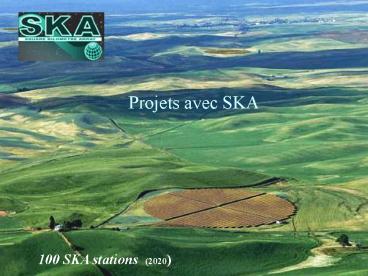100 SKA stations (2020) - PowerPoint PPT Presentation
Title:
100 SKA stations (2020)
Description:
Extra-galactic Key Projects KP-4 Galaxy evolution and cosmology ... (2) Large extra-galactic surveys : galaxy clusters, galaxies starbursts, with wide field ... – PowerPoint PPT presentation
Number of Views:48
Avg rating:3.0/5.0
Title: 100 SKA stations (2020)
1
Projets avec SKA
100 SKA stations (2020)
2
Telescope
- Project (2020) for a giant radiotelescope
- in the centimetre-metre ? range
- one square kilometre collecting surface
- 100 x more sensitive than present radio
telescopes - for spectral line observations
- 1000 x more sensitive than present radio
telescopes - for continuum observations
- frequencies 0.15 25 GHz (?
1.2cm 2m) - field of view 1 (? 100?) square
degrees at ? 21 cm / 1.4 GHz - 8
independent fields of view - angular resolution 0.01 arcsec
at ? 21 cm / 1.4 GHz - ? 100 stations of 100m diameter, baselines up
to 3000 km
3
Extra-galactic Key Projects
?KP-4 Galaxy evolution and cosmology
(surveys in HI at z up to 2, CO and continuum
nature of dark energy) ?KP-5 Probing the dark
ages (Epoch of Reionisation)
(HI in
emission/absorption, CO, continuum)
reionization
Wiggles, for tackling dark energy
4
Project Time-line
- ?Proposed sites Argentina, Australia, China,
South Africa - Site ranking/description 09/2006
- ?Proposed concepts phased array, large
parabolas/cylinders, LNSD - Concept selection 2009
- ?Design studies under way AUS, RSA CAN, CHN
USA - Europe (EC FP6 SKA Design Study 10 MEUR
EC) - French participation
- Construction of EMBRACE, a demonstrator of the
european - phased array SKA concept (at Westerbork and
Nançay in 2007) - RD towards the choice of this concept for the
SKA - Scientific modeling (cosmology Horizon team)
- ? Start construction 100,000 m2 SKA pathfinder on
the site 2010 - Construction of full-scale SKA 2014-2020
5
Field of view
Point source sensitivity of 10 nano-Jy in 8hours
At least 1 square degree Goal 50-100 sq deg.
6
Multi-Beam
7
EMBRACE
Electronic MultiBeam Radio Astronomy ConcEpt
?THEA array of 1 sq m, built at
ASTRON Beamforming system below, to form 2 fields
of view ?Schematic view of EMBRACE demonstrator
(fibre network) 100 m2
8
KP 4 - Galaxy evolution and cosmology
1- HI line surveys All-sky survey would contain
a billion galaxies out to z1.5 ? Galaxy
evolution studies using the most abundant
element 2- Dark Energy-measuring-machine -
acoustic peaks in baryons as function of z - weak
gravitational lensing in large fields ?Measure DE
parameters w0 and w1 to 1 accuracy
9
HI Line surveys
HI surveys ?main reservoir of star formation,
galaxy evolution stage ? tracer of DM in
galaxies ? various environments, groups,
clusters, interactions All-sky HI surveys
presently out to z0.04, no evolution
information SKA All-sky HI survey is needed out
to cosmological distances, to
distinguish between various evolution models -
All-sky survey would contain a billion galaxies
out to z1.5 - Deeper, targeted surveys ten
million galaxies at 2.5ltzlt3.5 Feasible in 1 year
if field-of-view large enough (gt10 deg2)
10
Dark energy measuring machine I-Wiggles
Billion galaxies at z 1-2
II- Weak Shear 10 billion galaxies, 10 nanoJy
11
SNAP and SKA compared
Resolution and Sky area 2000 SN 0.1ltzlt1.7
12
KP 5 - Probing the dark ages
1- Epoch of Reionisation (EoR) occurs at z6 (?)
HI line observations at high z to study
ionisation as function of z HI emission
tomography HI absorption towards first
radio-loud objects 2- First luminous objects
CO line and continuum detections at lt20 GHz
CO(1-0) at zgt5, detection rate like ALMA for high
transitions unobscured views of unprecedented
numbers of AGNs etc.
13
Possible double re-ionization scenario
Furlanetto et al 2004
14
Simulation of Reionization
z11.5
Ionizing - Background
log(f_HI)
log(gas density)
Gnedin (2000)
log T
z7
z4.9
15
When is the re-ionisation completed?
Mass
Volume
Gnedin 2004
Different ionisation histories With the same
zrei OTVET method for RT
16
Signal from the EoR period, at 21cm
20x20 , Scale in T(mK)
Gnedin Shaver 2004
17
Probing the dark age
- Use redshifted 21 cm emission to find the
tomography - of neutral hydrogen.
Problems
- The intensity of neutral hydrogen at high
redshifts is 100 to 1000 times smaller than
foreground sources. - Incomplete modeling available for foreground
sources in power spectra and evolution. - need to remove the signals from brighter sources
- Radio Galaxies
- Radio Relics Synchrotron Emission
- Radio Halos Synchrotron Emission
- Free-free and line emission from the interstellar
medium
18
Removal of foregrounds
Final angular correlation function derived from
calculations, observations, and lots of
simulations with several assumptions (even on
emission of stars!) The 21 cm line is much weaker
than several of the other signalshowever with
processes for data analysis and simulations, it
might be possible to meet the challenge
19
LOFAR precursor of SKA
New generation of radio-telescopes, with phased
arrays l gt 1.2m Low-cost antennae15000 over
100km, then 25000 over 350km Cost from
electronics A few Terabits/s, CPU 10s of
Teraflops Operated ny Netherlands Astro,
Geophysics, Agro-technologies sensors will
use optic fiber arrays, and IBM processors (1)
Reionisation epoch (2) Large extra-galactic
surveys galaxy clusters, galaxies starbursts,
with wide field (3) Transient phenomena (GRB, SN,
LIGO...) instantaneous beam (4) UHE cosmic rays,
recently detected with LOPES (LOFAR prototype
station) (5) Pulsars
20
In the middle of band 1 arsec resolution 100
sqdeg field 1mJy sensitivity Demonstration
antennae are operationnal Construction begins
end of 2005 5 spiral arms with compact core
Will serve to learn how to observe with SKA
21
Timeline































